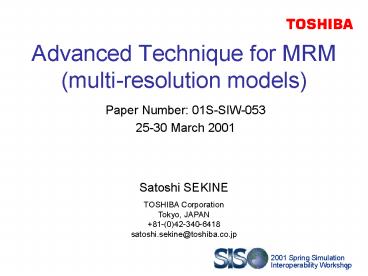Advanced Technique for MRM multiresolution models PowerPoint PPT Presentation
1 / 19
Title: Advanced Technique for MRM multiresolution models
1
Advanced Technique for MRM (multi-resolution
models)
Paper Number 01S-SIW-053 25-30 March 2001
Satoshi SEKINE TOSHIBA CorporationTokyo,
JAPAN81-(0)42-340-6418satoshi.sekine_at_toshiba.co
.jp
2
Contents
- Introduction
- Background and Objectives
- Methodology
- Apply to the traffic simulation
- Prototype
- Conclusion and Future works
3
Introduction
- Multi-resolution model(MRM) is simulation model
which has various kind of resolution.
4
Background and Objectives
- MRM simulation is very useful to evaluate huge
and complex systems - Many research and development about MRM.
- But, few study about the method to determine the
resolution of models. - This paper presents a framework to decide the
resolution of models.
5
Methodology
- Entity-level model high resolution
- Accurate conclusion
- Much time to calculate and computer resources
- Aggregate model low resolution
- Inaccurate conclusion
- Save the time to calculate and computer
resources. - We have to decide an adequate resolution of
models to analyze the system.
6
Framework
- Select the simulation model according to the
conditions or the state variables.
7
Select models
- Examples of Condition to select the simulation
model - Position or area in Simulation space.
- Time or period in Simulation time.
- The specific state variables of simulation
models. - We can also change the resolution of models
dynamically.
8
Apply to the traffic simulation
- Aggregate models represent a party of several
vehicles or a flow. - Entity-level models represent individual vehicle
and its behavior or the relationship.
9
Aggregate model
- Block density model
- Divide the road (link) as small parts (blocks).
- The traffic flow closely to a fluid.
- Define the Q-K relationship of traffic quantity
and block density. - Calculate the traffic flow based on the Q-K
relationship and preservation law of traffic.
10
Block density model
- Calculate the traffic between blocks based on the
Q-K relationship and preservation law of traffic
11
Entity-level model
- Road and vehicle model
- Represents the vehicle controller and dynamics
- Includes state variables such as position,
velocity - Switch the velocity and head to head distance
control.
12
Aggregation and disaggregation
- Aggregation
- The density of block
- Traffic quantity at the exit of block
- Disaggregation
- The number of vehicle
- The vehicle velocity
- Vehicles running on the block with equal distance
13
Prototype configuration
- Prototype simulator to verify to the proposed MRM
simulation system. - Class configuration.
- MrmSim, Field, Block, Vehicle
- Implemented as an applet of Java language.
14
Prototype GUI
- Gray color represents the aggregate model.
- White background represents the entity-level
model. - A vertical short dash is a vehicle.
- Buttons which control the simulation execution.
15
Two simulation examples
- We show two examples of traffic simulation by the
prototype simulator. - Case 1
- Simulation model is selected according to the
vehicle position. - Case 2
- Simulation model is selected according to the
block density.
16
Simulation case1
- Selecting according to the vehicle position
17
Simulation case2
- Selecting according to the traffic density
18
Conclusion
- The MRM simulation system which determine the
resolution of the models according to state
variables of simulation objects or environment
situations. - Application to the traffic simulation and the
prototype of simple traffic simulator - Show two examples of simulation which verify the
usefulness of this method.
19
Future works
- Investigation to the more complex traffic
networks - Analyze the amount of calculation and computer
resources concretely - Application to another fields.
20
Contacts
Satoshi SEKINE TOSHIBA CorporationSystem
Integration Technology Center 3-22,
Katamachi Fuchu,TokyoJAPANPhone
81-(0)42-340-6418Facsimile 81-(0)42-340-6013E
-mail satoshi.sekine_at_toshiba.co.jp
Makoto KANOU makoto.kanou_at_toshiba.co.jp
Akira HIGASHIDEakira.higashide_at_toshiba.co.jp
Michihiko OGATA miki.ogata_at_toshiba.co.jp

